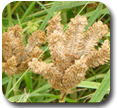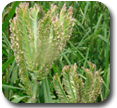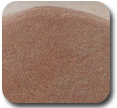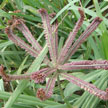Ragi - Eleusine coracana
Vernacular Names
English: African Millet, Finger Millet
Hindi: Ragi, Mandika, Marawah, Mandua
Kannadam: Ragi
Malayalam: Muthari, Ragi
Tamil: Keppai, Ragi, Kelvaragu
Telugu: Ragi, Chodi
 Top of page
Top of page
Classification of Ragi
Kingdom: Plantae
Division: Magnoliophyta
Class: Liliopsida
Order: Poales
Family: Graminae
Subfamily: Chloridoideae
Genus: Eleusine
Species: Coracana
 Top of page
Top of page
Parts of Ragi Plant
 |
 |
 |
 |
 |
 |
Root
- Ragi is having fibrous root system
- It is shallow, branched, rooting at lower nodes
- As the ragi grain germinates, the radical pierces its way out and forms the seminal root
- Lateral roots are formed from the seminal root
- As the seedlings begin to grow, fibrous roots arise from the basal nodes
- When seedlings are pulled out, most of the roots get torn off but very soon fresh roots develop
 Top of page
Top of page
Stem
- It is slender, erect, compressed, glaborous and smooth, sometimes branching
- The stem is compressed, elliptic and it is green in colour
- The plant is robust, free tillering, tufted annual grass up to 170 cm tall
- The stem is hollow at the internodes and solid at the nodes
- The lower internodes are short and the longest being the terminal node carrying the inflorescence
 Top of page
Top of page
Leaf
- The plant has a packing of a large number of leaves on short slender culms
- The leaves are arranged alternately on either side of the compressed elliptical culm and it is green in colour. The leaves are distichous, simple and entire
- The leaf sheath envelops the stem lore or less completely and very little of internodes are exposed. The leaf sheath is flattened, over lapping, split along the entire length
- The leaf blade has a prominent midrib, ligule, a fringe of hairs. Leaf blade is linear and taper to an acute point, folded and striated and often with ciliated margins. Ligule is 1 to 2 mm long, fimbriate
- Many of the well grown leaves have a tendency to snap and bend down about their upper middle and called as bent leaves
- The internodes of the culm are not of equal length.
- At the base of the stem, the nodes are often crowded are referred as ‘conjested nodes’. Two to four nodes get conjested together in the culms
 Top of page
Top of page
Panicle
- Inflorescence or Panicle is borne at the end of the vegetative shoot. It is branched with one or a few branches below the main cluster of 4-19 branches.
- It is borne on a long peduncle. The panicle consists of a variable number of spikes ranging from 3 to 20 arranged in a bird’s foot style. It resembles fingers on hand, hence its common name is finger millet and with an odd one a little lower down the whorl and called the thumb.
- The rachis of the spikes is flat
- The branches are slender to robust, linear to oblong, up to 24 cm long, each branch with 60-80 spikelets
- There are four types of panicle shapes, namely, (i) the top-curved, (ii) the in-curved, (iii) the open and (iv) the fisty
- In the in-curved, the fingers are short and curve in and practically close up the central hollowgiving the earhead an obovate shape
- In the top-curved, the curved fingers are longer with the result that they retain the central hollow
- In the open, the fingers are the longest and gape out and present a characteristic funnel-shaped appearance
- The fisty has the in-curved spikelets in a greater intensity of curving giving a roundish, fist-like appearance
 Top of page
Top of page
Spikelets
- The spikelets are carried on small rachillae at the ends of the branches of the panicle
- They are often curved, crowded, 2 to 4 flowered
- They are ovoid-ellipsoid, up to 10 mm
- They are sessile and arranged in 2 rows alternately attached to one side of the rachis
- Spikelets about 70 arranged alternately on rachis, each containing 4 to 7 seeds
- Each spikelet is 3 to 7 flowered enclosed by the lemma and palea
- The lower glume is ovate, obtuse and keeled with lateral nerve close to the keel
- The upper glume is similar, but slightly longer
- The lower 2 glumes are 1-4 mm long with 5-7 veined keels and it is barren
- Enclose bisexual flowers, but terminal ones sometimes sterile or male, arranged in two opposite rows and two lodicules each
- Flowering lemmas are broadly ovale, acute, three nerved and 2-5 mm long
- Palea slightly shorter than lemma, two keeled with the keel wings
- There are two lodicules broad and trunky
- Stamens three, ovary superior with two dsitinct free styles ending in plumose stigmas
- The four types of ear heads, not withstanding their varying finger lengths, do not present very marked differences in the number of spikelets on a finger. The average number of spikelets in a finger had been found to be 67 to 73
- In each spikelet, the opening of the florets is from bottom to top and one floret in the spikelet opens per day. An earhead takes seven to eight days to complete its flowering
 Top of page
Top of page
Grain
- The grain is globose and smooth one with the pericarp thin, hyaline and loose
- The naked grain is more or less spherical in shape and the colour can be brown, reddish brown, black, orange red, purple and white
- The base of the grain is slightly flattened with a small depression called as hilum.
- The grain shows a slight flattening, which marks the position of the embryo
- The seed coats are developed from the two integuments of the ovule which are free from each other except at the base.
- The inner layer has cells which are twice as large as that of the outer layer in the initial stages
- The outer layer is thrown into a number of projections, probably as a result of shrinkage of cells and shows numerous more or less concentric configurations as seen in a mature grain




